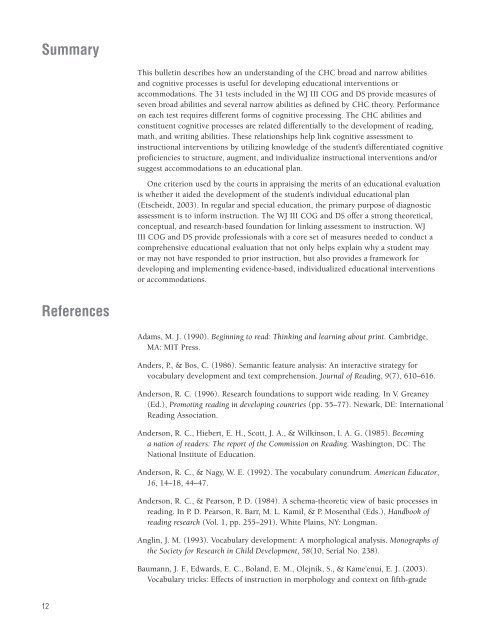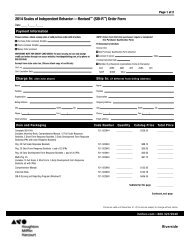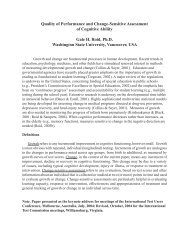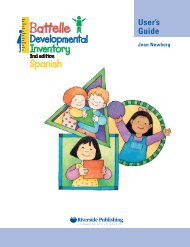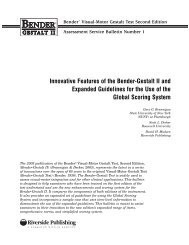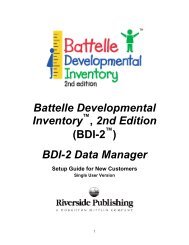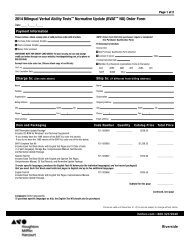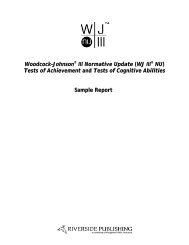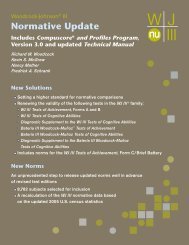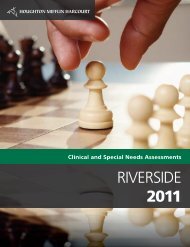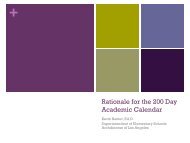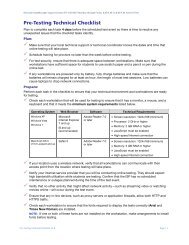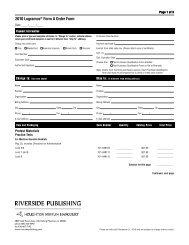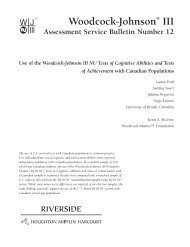Woodcock- Johnson III Tests of Cognitive Abilities - Riverside ...
Woodcock- Johnson III Tests of Cognitive Abilities - Riverside ...
Woodcock- Johnson III Tests of Cognitive Abilities - Riverside ...
You also want an ePaper? Increase the reach of your titles
YUMPU automatically turns print PDFs into web optimized ePapers that Google loves.
SummaryThis bulletin describes how an understanding <strong>of</strong> the CHC broad and narrow abilitiesand cognitive processes is useful for developing educational interventions oraccommodations. The 31 tests included in the WJ <strong>III</strong> COG and DS provide measures <strong>of</strong>seven broad abilities and several narrow abilities as defined by CHC theory. Performanceon each test requires different forms <strong>of</strong> cognitive processing. The CHC abilities andconstituent cognitive processes are related differentially to the development <strong>of</strong> reading,math, and writing abilities. These relationships help link cognitive assessment toinstructional interventions by utilizing knowledge <strong>of</strong> the student’s differentiated cognitivepr<strong>of</strong>iciencies to structure, augment, and individualize instructional interventions and/orsuggest accommodations to an educational plan.One criterion used by the courts in appraising the merits <strong>of</strong> an educational evaluationis whether it aided the development <strong>of</strong> the student’s individual educational plan(Etscheidt, 2003). In regular and special education, the primary purpose <strong>of</strong> diagnosticassessment is to inform instruction. The WJ <strong>III</strong> COG and DS <strong>of</strong>fer a strong theoretical,conceptual, and research-based foundation for linking assessment to instruction. WJ<strong>III</strong> COG and DS provide pr<strong>of</strong>essionals with a core set <strong>of</strong> measures needed to conduct acomprehensive educational evaluation that not only helps explain why a student mayor may not have responded to prior instruction, but also provides a framework fordeveloping and implementing evidence-based, individualized educational interventionsor accommodations.ReferencesAdams, M. J. (1990). Beginning to read: Thinking and learning about print. Cambridge,MA: MIT Press.Anders, P., & Bos, C. (1986). Semantic feature analysis: An interactive strategy forvocabulary development and text comprehension. Journal <strong>of</strong> Reading, 9(7), 610–616.Anderson, R. C. (1996). Research foundations to support wide reading. In V. Greaney(Ed.), Promoting reading in developing countries (pp. 55–77). Newark, DE: InternationalReading Association.Anderson, R. C., Hiebert, E. H., Scott, J. A., & Wilkinson, I. A. G. (1985). Becominga nation <strong>of</strong> readers: The report <strong>of</strong> the Commission on Reading. Washington, DC: TheNational Institute <strong>of</strong> Education.Anderson, R. C., & Nagy, W. E. (1992). The vocabulary conundrum. American Educator,16, 14–18, 44–47.Anderson, R. C., & Pearson, P. D. (1984). A schema-theoretic view <strong>of</strong> basic processes inreading. In P. D. Pearson, R. Barr, M. L. Kamil, & P. Mosenthal (Eds.), Handbook <strong>of</strong>reading research (Vol. 1, pp. 255–291). White Plains, NY: Longman.Anglin, J. M. (1993). Vocabulary development: A morphological analysis. Monographs <strong>of</strong>the Society for Research in Child Development, 58(10, Serial No. 238).Baumann, J. F., Edwards, E. C., Boland, E. M., Olejnik, S., & Kame’enui, E. J. (2003).Vocabulary tricks: Effects <strong>of</strong> instruction in morphology and context on fifth-grade12


